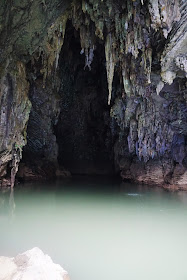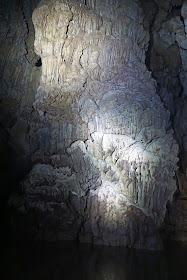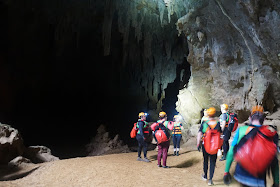Day two of a three day guided trek of the Wild Tu Lan Explorer with Oxalis Adventure Tours, the second day takes hikes through three caves between Tu Lan and To Mo Valleys. Starting with a side trip to Ken Cave before continuing on to Tu Lan Cave, the day's trekking becomes increasingly rugged, culminating in a tough scramble and swim through Hang Kim Cave
Distance: ???
Gradient: Some very steep ascent and descents over the course of the day, with some scrambling required.
Quality of Path: Largely clear and well maintained through the jungle, with some uneven sections of rocky limestone. No formed path through the caves, some of which requires swimming.
Quality of Signage: Non-existent; this is a guided walk that must be done with Oxalis Adventure Tours.
Experience Required: Previous Walking Experience Recommended
Time: 7Hours
Steps: Informal steps throughout with some ladders.
Best Time to Visit: Not during the wet season.
Entry Fee: Yes; walk must be completed with Oxalis Adenture Tours.
Getting There: Pick up from a local hotel is included in the price of the tour.Entry Fee: Yes; walk must be completed with Oxalis Adenture Tours.
After a tough first day of jungle trekking, Alissa and I slept really well in our tent, with the white noise sound of the running water coming from the river nearby providing particularly conducive conditions. With our cooks preparing a lovely breakfast of crepes (much to Alissa's taste) and stir fried noodles (much to mine), we had a bit of a lazy start waiting for the last stragglers in our group to get ready for the day ahead.
Our day of cave exploration began with us leaving our bags at the Tu Lan Valley campsite as we headed out for a side trip to the nearby Ken Cave. To get there, we had to cross the river at a shallow point that was no more than knee deep, however our guides challenged us to see if we could make it across by swinging via a series of aerial roots. From memory, I don't think anyone was actually able to get to the other side without getting their feet wet, and Alissa and I simply waded across.
Along the trail into the cave, we were able to see the waterfall that was visible from the campsite up close. Our guides had informed us that the water levels were quite high at this time of the year, and that in later months it would be possible to access the cave straight up the waterfall.
While climbing up a waterfall sounded pretty cool, this was a ruggedly beautiful and awe-inspiring entry to the cave and a great section of trail.
Although Alissa and I have visited many caves in the past, this was our first time seeing a cave with a river flowing right through it. Although we had seen photos of the caves before booking the tour, the reality was far more incredible than we could have imagined. Seriously, the photos do not do justice to how incredible this cave is.
Before heading further into the cave, Ken took a photo of our group. With the water levels being quite high, Ken and Hiếu gave us the option of either swimming upstream in the cave or to be ferried inside by one of the porters. The majority chose to take the raft, however after a sweaty previous day, I decided I wanted to go in for a swim.
At first, paddling backwards was fairly easy and it was lovely looking up at the huge cavernous space around us. I was so distracted by the lovely views that I hadn't realised that I had become caught in the current. While I'm not an expert swimmer, I can usually swim well enough, but the combination of life vest, helmet and boots made it very difficult to go against the current and I have to admit struggling a bit. Thankfully Ray - another Aussie guy on the trail with us - saw me struggling and came to my aid as he pulled me along to a wide platform on the other side of the cave.
The view back towards the cave entrance was excellent. With the jungle outside, it really looked like something out of Jurassic Park - which is probably why the Tu Lan cave system was used so extensively as a location for King Kong: Skull Island. After stopping to take photos at this first dry section of the cave, we continued along to the next dry section.
This next section of the cave featured one of the hike's most famous locations. Famously photographed by Carsten Peter for National Geographic, the massive column pictured above is one of the most impressive cave formations I've seen, and one that puts the formations in our local Margaret River caves back home to shame.
At the complete opposite end of the scale, the cave was also filled with smaller wonders such as the animals living in the caves. Of particular note were the massive spiders, some of which were as big as a hand!
While the swim in was an upstream challenge, it was a very easy float back out of the cave. This gave all of us who chose to swim out the opportunity to really take in Ken Cave's beauty. As we were floating out, Ray and I kept saying that we couldn't believe that this particular walk was not more well known internationally as everything we'd seen so far was incredible.
Once back at the cave entrance, we walked back to the Tu Lan Valley campsite for a delicious cooked lunch and a bit of a break.
After lunch, Ken and Hiếu prepared our raft so we could start the next part of our adventure.
Hopping onto the raft, the group floated down the river as we were taken to Tu Lan Cave - the namesake cave of the system we had been exploring.
While I definitely enjoyed swimming into Ken Cave, I enjoyed the rafting as a photographer as it gave me an opportunity to take a lot of photos of the stalactites near the cave entrance.
The first bit of our journey into Tu Lan Cave saw us remain on the raft as the guides took us to the limits of where it was safe for us to explore. There were a number of beautiful cave formations in this section, however the ominous sound of rushing water in the darkness further upstream was a clear indication of the dangers of continuing on; our guides confirmed that while the cave continues for several kilometres along the river passage, they are not allowed to take visitors any further that a certain point due tonsafety concerns.
During the wet season, the danger of flash flooding completely closes the cave, and Hiếu pointed out some twigs stuck to the cave's ceiling as a clear indication of how high the water levels can get.
Heading back upstream, the guides lead us to a huge column on one side of the cave. Behind the column was the location of a dry passage we would be following on foot.
The first part of the dry passage saw the group scramble up through the cave, with people literally scrambling above each other as we followed the zig-zagging path up to the next chamber.
Although Alissa and I had some experience with scrambling up through a cave when we did the Stapylton Amphitheatre walk in the Grampians, this was a much higher, longer and adventurous scramble, with the added challenge of darkness and potentially slippery, wet surfaces.
After clearing the scrambling section, the group reached a relatively flat and long dry chamber in Tu Lan Cave that would eventually lead us through to the cave's exit.
On one side of the cave were a series of naturally formed shelves that looked like they could be the cascading tiers of a water feature. At the time of our visit, the shelves were largely dry, however I can imagine these overflowing with water during the wet season.
Ken - a good photographer in his own right - volunteered to model for the photo above. Using a long exposure and placing the camera on a sturdy rock, the porters helped light the space by moving their torches back and forth to paint the light into the photograph above.
Continuing along, we were led to a section of Tu Lan Cave dominated by a series of spectacular columns and stalactites.
While smaller than the massive column in Ken Cave, these columns were particularly beautiful due to their varied textures and shapes; they almost had an organic quality that recalled everything from H.R. Giger to the shape of a cauliflower.
Just before the end of the cavern, the cave reached a fittingly impressive finale in the form of a massive column.
From there, it was only a short walk to Tu Lan Cave's dry exit. The long, wide entryway was arguably the most beautiful of all the cave entrances we saw in the Tu Lan Cave System, with stunning views of the jungle beyond.
From Tu Lan Cave, we followed our guides through the jungle as we followed the trail to Hang Kim Cave.
The route between Tu Lan and Hang Kim featured some stunning and adventurous moments, and even went past a number of other minor caves. One of the highlights of this section was a waist deep river crossing, which while fairly deep was pretty easy going.
Post from RICOH THETA. - Spherical Image - RICOH THETAThe best part of this trekking section - and one of the highlights of the entire day - was a stunning waterfall along the track. We all stopped to take photos of the falls in action before continuing onwards.
While the first waterfall was easily the most beautiful, we encountered a number of other waterfalls. Indeed - the trail itself required us to walk up a series of cascades before returning to an obvious trail.
Heading away from the waters and climbing up through limestone rock formations, we reached a resting point. Our porters had left our bags here for us, and for the first time of the day we would be required to carry our bags with us from this point onwards to the To Mo Valley campsite.
After a quick break, we began our ascent through the jungle to Hang Kim Cave's entrance, which required a fair bit of scrambling.
Even more scrambling would be required once we got into the cave, with the route requiring us to climb through narrow passageways as to upper sections of the cave. This was some of the most fun scrambling of the whole day, with a lot of easy hand holds to make the job adventurous but relatively straightforward.
Once we cleared the scrambling section, we stopped near an alternate entrance to the cave. While the scree slope would have been relatively easy to climb out of, we would instead be taking a far more challenging way out of Hang Kim Cave.
The next section of the cave was arguably the most difficult and challenging sections of the entire three days, and unfortunately required so much swimming and scrambling that I had to put my camera away. From the alternate cave access, we continued on into the darkness pictured above as we climbed along a narrow ledge in the cave. For an illustration of the kind of scrambling required, it was quite similar to the ledge walking in Hancock Gorge in Karijini National Park, except that the ledge was more slippery and higher above fast moving water with the possibility of falling into submerged rock. This was alternated with some very difficult swimming upstream that was even harder than what we encountered in Ken Cave and walking up and over rocks with water flowing over them. Although not necessarily difficult, the most daunting part of the walk required us to scramble around a corner along a high narrow ledge with a lot of exposure. While there were plentiful hand holds to make this quite achievable, the slippery nature of the wet, muddy walking and the substantial drop down made it that bit scarier than it would be otherwise.
After exiting the cave, it was a surprisingly short walk to To Mo Valley campsite after a quick swim across the river. Alissa had very bravely held it together through the tough challenges of Hang Kim Cave, however we found a spot for Alissa to a quiet cry before we joined the group, put our packs down and changed into comfortable dry clothes.
While this was easily the most difficult day of the Wild Tu Lan Explorer due to the scrambling and cave swimming, Alissa and I agreed that Tu Lan Valley to To Mo Valley was the best day of the entire three days as it was the most cave-centric of the three days and arguably features the three most incredible caves. From start to finish, this day was eventful and awe-inspiring, with floating out of Ken Cave, the scrambling in Tu Lan and Hang Kim Caves and the waterfall in the jungle trekking section being some of the three day walk's best moments. This day alone makes the Wild Tu Lan Cave Explorer tour entirely worthwhile, and would rank up there as one of my favourite days of hiking.











































No comments:
Post a Comment